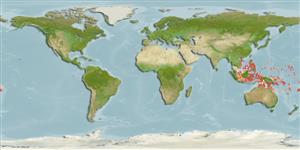>
Gobiiformes (Gobies) >
Gobiidae (Gobies) > Gobiinae
Etymology: Eviota: No etymology given, suggested by Christopher Scharpt: from Latin 'eu' for 'true' and 'iota' for anything very small, in combination 'truly very small' referring to it as being the smallest vertebrate at the time it has benn described by Jenkins (thus, making the suggestion by Scharpt plausible.
More on authors: Jewett & Lachner.
Environment: milieu / climate zone / depth range / distribution range
Ecología
marino asociado a arrecife; rango de profundidad 1 - 29 m (Ref. 86942). Tropical; 19°N - 20°S
Western Central Pacific: Fiji where there are confirmed records from numerous localities. Other records from throughout the western Pacific Ocean may represent a species complex.
Tamaño / Peso / Age
Maturity: Lm ? range ? - ? cm
Max length : 2.1 cm SL macho / no sexado; (Ref. 113727)
Short description
Claves de identificación | Morfología | Morfometría
Espinas dorsales (total) : 7; Radios blandos dorsales (total) : 8 - 10; Espinas anales: 1; Radios blandos anales: 7 - 8. This species is distinguished by the following characters: cephalic sensory-canal pore system lacking only the IT pore (pattern 2); branched pectoral-fin rays; dorsal/anal-fin formula 9/8; the fifth pelvic-fin ray is 10-20% of fourth ray; absence of postocular spot; without dark spot on preural centrum area nor prominent dark spots on pectoral-fin base; caudal fin with strong scattered well-spaced dark spots (Ref. 107299).
Inhabits sheltered reefs in 1-20 m (Ref 90102). Occupies a limited range of substrates: dead reef, dead reef with silty sand, silt, and also fine sand (Ref. 116739).
Life cycle and mating behavior
Madurez | Reproducción | Puesta | Huevos | Fecundidad | Larva
Greenfield, D.W. and R. Winterbottom, 2016. A key to the dwarfgoby species (Teleostei: Gobiidae: Eviota) described between 1871 and 2016. J. Ocean Sci. Found. 24:35-90. (Ref. 113727)
IUCN Red List Status (Ref. 130435: Version 2024-1)
Threat to humans
Harmless
Human uses
Herramientas
Special reports
Download XML
Fuentes de Internet
Estimates based on models
Phylogenetic diversity index (Ref.
82804): PD
50 = 0.5000 [Uniqueness, from 0.5 = low to 2.0 = high].
Bayesian length-weight: a=0.00692 (0.00284 - 0.01683), b=3.10 (2.92 - 3.28), in cm total length, based on LWR estimates for this Genus-body shape (Ref.
93245).
Nivel trófico (Ref.
69278): 3.1 ±0.3 se; based on size and trophs of closest relatives
Resiliencia (Ref.
120179): Alto, población duplicada en un tiempo mínimo inferior a 15 meses (Preliminary K or Fecundity.).
Fishing Vulnerability (Ref.
59153): Low vulnerability (10 of 100).
Nutrients (Ref.
124155): Calcium = 484 [196, 1,654] mg/100g; Iron = 1.82 [0.73, 4.28] mg/100g; Protein = 17.5 [15.4, 19.5] %; Omega3 = 0.108 [0.032, 0.339] g/100g; Selenium = 38.1 [9.9, 125.7] μg/100g; VitaminA = 105 [18, 570] μg/100g; Zinc = 5.02 [2.57, 8.75] mg/100g (wet weight);
